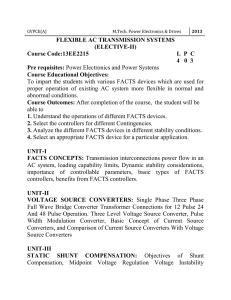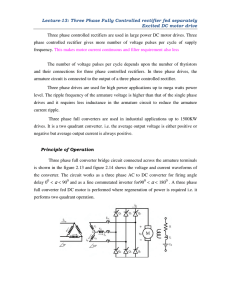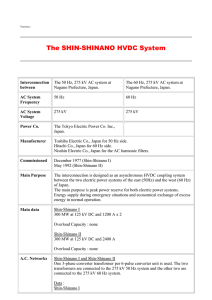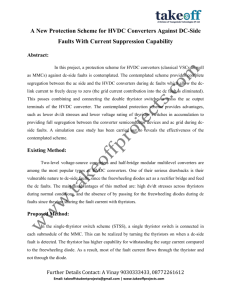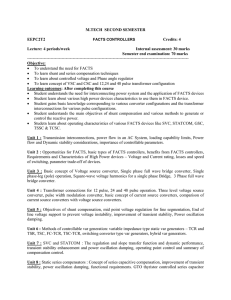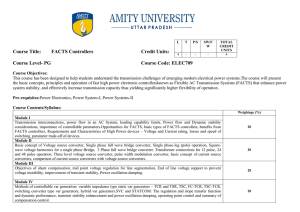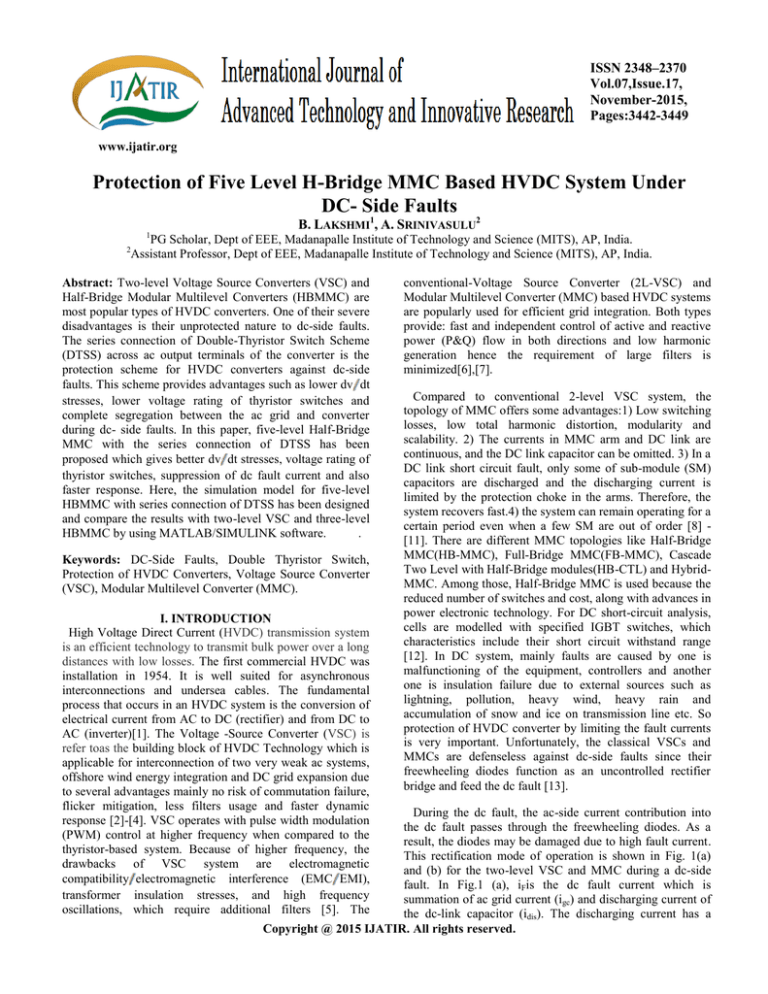
ISSN 2348–2370
Vol.07,Issue.17,
November-2015,
Pages:3442-3449
www.ijatir.org
Protection of Five Level H-Bridge MMC Based HVDC System Under
DC- Side Faults
B. LAKSHMI1, A. SRINIVASULU2
1
PG Scholar, Dept of EEE, Madanapalle Institute of Technology and Science (MITS), AP, India.
Assistant Professor, Dept of EEE, Madanapalle Institute of Technology and Science (MITS), AP, India.
2
Abstract: Two-level Voltage Source Converters (VSC) and
Half-Bridge Modular Multilevel Converters (HBMMC) are
most popular types of HVDC converters. One of their severe
disadvantages is their unprotected nature to dc-side faults.
The series connection of Double-Thyristor Switch Scheme
(DTSS) across ac output terminals of the converter is the
protection scheme for HVDC converters against dc-side
faults. This scheme provides advantages such as lower dv dt
stresses, lower voltage rating of thyristor switches and
complete segregation between the ac grid and converter
during dc- side faults. In this paper, five-level Half-Bridge
MMC with the series connection of DTSS has been
proposed which gives better dv dt stresses, voltage rating of
thyristor switches, suppression of dc fault current and also
faster response. Here, the simulation model for five-level
HBMMC with series connection of DTSS has been designed
and compare the results with two-level VSC and three-level
HBMMC by using MATLAB/SIMULINK software.
.
Keywords: DC-Side Faults, Double Thyristor Switch,
Protection of HVDC Converters, Voltage Source Converter
(VSC), Modular Multilevel Converter (MMC).
I. INTRODUCTION
High Voltage Direct Current (HVDC) transmission system
is an efficient technology to transmit bulk power over a long
distances with low losses. The first commercial HVDC was
installation in 1954. It is well suited for asynchronous
interconnections and undersea cables. The fundamental
process that occurs in an HVDC system is the conversion of
electrical current from AC to DC (rectifier) and from DC to
AC (inverter)[1]. The Voltage -Source Converter (VSC) is
refer toas the building block of HVDC Technology which is
applicable for interconnection of two very weak ac systems,
offshore wind energy integration and DC grid expansion due
to several advantages mainly no risk of commutation failure,
flicker mitigation, less filters usage and faster dynamic
response [2]-[4]. VSC operates with pulse width modulation
(PWM) control at higher frequency when compared to the
thyristor-based system. Because of higher frequency, the
drawbacks of VSC system are electromagnetic
compatibility electromagnetic interference (EMC EMI),
transformer insulation stresses, and high frequency
oscillations, which require additional filters [5]. The
conventional-Voltage Source Converter (2L-VSC) and
Modular Multilevel Converter (MMC) based HVDC systems
are popularly used for efficient grid integration. Both types
provide: fast and independent control of active and reactive
power (P&Q) flow in both directions and low harmonic
generation hence the requirement of large filters is
minimized[6],[7].
Compared to conventional 2-level VSC system, the
topology of MMC offers some advantages:1) Low switching
losses, low total harmonic distortion, modularity and
scalability. 2) The currents in MMC arm and DC link are
continuous, and the DC link capacitor can be omitted. 3) In a
DC link short circuit fault, only some of sub-module (SM)
capacitors are discharged and the discharging current is
limited by the protection choke in the arms. Therefore, the
system recovers fast.4) the system can remain operating for a
certain period even when a few SM are out of order [8] [11]. There are different MMC topologies like Half-Bridge
MMC(HB-MMC), Full-Bridge MMC(FB-MMC), Cascade
Two Level with Half-Bridge modules(HB-CTL) and HybridMMC. Among those, Half-Bridge MMC is used because the
reduced number of switches and cost, along with advances in
power electronic technology. For DC short-circuit analysis,
cells are modelled with specified IGBT switches, which
characteristics include their short circuit withstand range
[12]. In DC system, mainly faults are caused by one is
malfunctioning of the equipment, controllers and another
one is insulation failure due to external sources such as
lightning, pollution, heavy wind, heavy rain and
accumulation of snow and ice on transmission line etc. So
protection of HVDC converter by limiting the fault currents
is very important. Unfortunately, the classical VSCs and
MMCs are defenseless against dc-side faults since their
freewheeling diodes function as an uncontrolled rectifier
bridge and feed the dc fault [13].
During the dc fault, the ac-side current contribution into
the dc fault passes through the freewheeling diodes. As a
result, the diodes may be damaged due to high fault current.
This rectification mode of operation is shown in Fig. 1(a)
and (b) for the two-level VSC and MMC during a dc-side
fault. In Fig.1 (a), iFis the dc fault current which is
summation of ac grid current (igc) and discharging current of
the dc-link capacitor (idis). The discharging current has a
Copyright @ 2015 IJATIR. All rights reserved.
B. LAKSHMI, A. SRINIVASULU
large first peak that decays with time [14].In Fig. 1(b), the
devices by sharing the fault current with the freewheeling
common dc-link capacitor is not utilized, which helps
diodes and simultaneously prevent the grid current
suppress the discharge current [15].Here, ac grid current (i gc)
contribution which allows the dc-link current to freely decay.
still exist that means three is no segregation between dc and
The main disadvantages of this method are as follows:
ac sides during dc faults. Because of high cost and high
During normal operation, both thyristors have to
conductance losses, dc circuit breaker (CB) may not be used
withstand high
stresses which may produce
to overcome the dc-side problems in HVDC converters. To
capacitive displacement current in the device, which can
achieve the required dc protection, AC CBs (ACCBs) may
cause undesirable turn on [20], [21].
be used [16].But freewheeling diodes should withstand the
Due to overvoltage spikes and
, the
fault current until the CB trips the semiconductor devices
semiconductor devices are damaged. So, a snubber
may be damaged due to high fault currents. To improve the
circuit is also essential to prevent damage [20].
reliability of ac CBs in dc protection, converter embedded
The freewheeling diodes are still sharing the fault
devices may be used in conjunction with the ac CBs [16].
current with the thyristors.
Complexity to design each MMC submodule with
DTSS.
To overcome above problems another protection scheme is
used, that is, series connection of DTSS switches across ac
output terminals of the converter [23].
II. SERIES CONNECTION OF DTSS
The arrangement of series connection of Double-Thyristor
Switch Scheme (DTSS) switches across acoutput terminals
of the converter is shown in Fig.2.Under normal operating
condition, the thyristors are turned off. When a dc-side fault
is initiated, the thyristors are turned on to segregate the
HVDC converter from the ac side. By using this protection
scheme, semiconductor devices of the converter are
protected as well as eliminate the grid current contribution
(i.e., complete segregation between the ac grid and dc side).
In case of two-level VSC shown in Fig.3, the equivalent
impedance (Zeq) is same before and after firing the thyristors
that means which is equal to interfacing impedance
(Zi).Thus, by turn on the thyristors, the required segregation
will be achieved without increasing the magnitude of ac fault
currents.
ig
Transformer
Zi
AC side
DC side
a
b
Fig. 1. HVDC converters during dc-side faults: (a) 2-level
VSC and (b) MMC.
c
In the Single-Thyristor Switch Scheme (STSS) [16]–[18], a
single thyristor switch is connected across each semiconductor device of the VSC and also each submodule of the
MMC. By using this scheme, overcurrent stresses on
semiconductor devices can be reduced due to sharing of fault
current with thyristor and freewheeling diode. Compared to
the freewheeling diode, the thyristor has high surge current
withstand capability [18].So, most of the fault current flows
through the thyristor and not through the diode. The STSS
protects the semiconductor devices but cannot prevent the
grid current contribution into the dc fault. To overcome that
problem, Double-Thyristor Switch Scheme (DTSS) is used
[19]. In this scheme, a double-thyristor switch (back-to-back
thyristor) is connected across each semiconductor device of
the VSC and also each submodule of the MMC. The
advantages of this scheme are protection of semiconductor
Grid
ACCBs
Interfacing
impedance
Converter
Fig.2. Series connection of DTSS against the dc-side
faults.
International Journal of Advanced Technology and Innovative Research
Volume.07, IssueNo.17, November-2015, Pages: 3442-3449
Protection of Five Level H-Bridge MMC Based HVDC System Under DC- Side Faults
Fig.3. Effect of thyristors firing on the equivalent
impedance seen by the grid, in 2-level VSC
configuration: (a) before and (b) after thyristors firing.
In case of MMC shown in Fig.4, the equivalent impedance
(Zeq) during a dc-side fault after firing the thyristors [Fig.
4(b)] is lower than its value before firing [Fig. 4(a)] because
of the arm inductors (Lo).The main two functions of the arm
inductor (Lo) are limiting the fault currents and suppression
of circulating currents [22].The value of inductor will be low
because the magnitude of ac current is not change during
faulted condition. By using this scheme, the following
advantages are gained [23].
During dc faults, the complete segregation of ac grid
and converter can be achieved.
The magnitude of ac current is same before and after
firing of the thyristor switches.
The dc-link current is freely decay to zero. At that
instant, disconnect the dc side fault carefully.
This protection scheme can give thyristors with lower
stresses and lower voltage ratings.
DC circuit breaker (DC CB) is not used because dc-link
current is freely decay to zero.
A.
Stresses and Voltage Rating of the Required
Thyristors
Thyristors are frequently exposed to a high rate of voltage
change during operation. This produces a capacitive
displacement current in the device, which can cause
undesirable turn on. This is known as the
effect
[20].So, each device maintains its blocking capability (i.e.,
capability). In Fig.2, The back-back thyristors are
combined and divided into two groups. For 2-level VSC and
MMC, 3 and 3n back- back thyristor switches per group are
required (where n is the number of sub- modules per
arm).The converter line voltage is applied across each group.
Fig.4. Effect of thyristors firing on the equivalent
impedance seen by the grid in MMC configuration: (a)
before and (b) after thyristors firing.
Conventional Two-Level VSC Case: During normal
operating conditions, the voltage across semiconductor
devices changes between 0 and Vsw. In this case, Vsw is equal
to the dc-link voltage (Vdc). Now, ±Vdc is the voltage step
with each change in converter line voltage
is shared
between three series back-to-back thyristor switches.
The
stresses across each thyristor in case of 2-level
VSC as follows:
Da
ia
Phase(a)
Sˈ
Phase(b)
S
Daˈ
Fig. 5. AC current paths during the dc-side fault.
(1)
Where Ton/off is the time required for the semiconductor device
to change its state from ON to OFF or vice-versa and Vdc is
the highest instantaneous value of converter line voltage. This
line voltage is shared by three series back-to-back thyristor
switches, that means, the voltage rating of the each thyristor is
(Vdc 3) may be used.
MMC Case: In this case, Vsw is equal to the dc-link voltage
(Vdc n).Now, ± Vsw is the voltage step with each change in
International Journal of Advanced Technology and Innovative Research
Volume.07, IssueNo.17, November-2015, Pages: 3442-3449
B. LAKSHMI, A. SRINIVASULU
converter line voltage is shared between 3n series back-toIII. PROPOSED SCHEME
back thyristor switches. The
stresses across each
Five level Half-Bridge Modular Multilevel Converter (5Lthyristor in case of MMC as follows:
HBMMC) with series connection of DTSS across ac output
(2)
The highest instantaneous value of converter line voltage
(Vdc) is shared by 3n series back-to-back thyristor switches,
that is, the voltage rating of the each thyristor is (V dc 3n) may
be used.
Three-level MMC: For three- level MMC (3L-MMC),
number of sub-modules per arm (n) is equal to 2. The
stresses across each thyristor in case of 3L- MMC as
follows:
(3)
The voltage rating of the each thyristor is (Vdc 3n), that is
equal to (Vdc 6) may be used.
terminals of the HVDC converter has been proposed due to
following benefits are gained.
Lower
stresses and lower voltage rating of the
thyristor switches.
The performance of dc fault current suppression
capability can be improved.
Low switching losses because of the lower switching
frequency compared to 2L-VSC and 3L-MMC
respectively.
Fast response in addition to get complete segregation
between ac grid and converter during dc-side fault.
The general diagram of MMC is shown in Fig.1(b) and also
the Simulink model for 5L-HBMMC is shown in Fig.7.In
case of five-level HBMMC, the number of sub-modules
perarm (n)is equal to 4 and the number of series connected
back-to-back.
TABLE I: Parameters of HVDC System Model
ig
Zi
Fig.6. Block diagram for the simulated HVDC system.
B. Current Rating of the Required Thyristors
During dc-side fault, the per- phase path of ac current as
shown in Fig.5.In case of series connection of DTSS across ac
output terminals of the HVDC converter, the total amount of
ac current flows through the thyristors as shown in Fig.6. The
steady-state currents of thyristors and diodes during a dc fault
are given by (4) and (5), respectively.
(4)
(5)
Where ia+ and ia-are the positive and the negative currents of
phase “a”. From above equations it is clear that the current
rating of the thyristors will be high compared to STSS and
DTSS because they carry the full ac current. For 2L-VSC and
3L-MMC configurations, the current rating of each thyristor
is Isc. Where Isc is the magnitude of ac current during dc-side
faults.
thyristor switches in each group (3n) is equal to 12.The
stresses across each thyristor in case of 5L-HBMMC
as follows:
International Journal of Advanced Technology and Innovative Research
Volume.07, IssueNo.17, November-2015, Pages: 3442-3449
(6)
Protection of Five Level H-Bridge MMC Based HVDC System Under DC- Side Faults
Where n = 4.The highest instantaneous value of converter
Stage II: Diode freewheel stage: This stage is started as the
line voltage (Vdc) is shared by 3n series back-to-back
dc fault commutates to the converter freewheeling diodes
thyristor switches, that is, the voltage rating of the each
when the dc-link voltage reaches zero and the cable
inductance drives the current around the freewheeling path.
thyristor is (Vdc 3n),that is equal to (Vdc 12) may be used.
At this stage, the initial diode currents are high which may
The current rating of thyristor is Isc .Here, Isc is the magnitude
damage them, then the current decays with time. This
of ac current during dc-side fault which is not changed (in
permits the dc-link current to decay freely to zero (dc fault
case of 2L-VSC, 3L-MMC and5L-MMC) because of series
current suppression capability).
connection of back-to-back thyristor switches across ac
output terminals of the converter.
TABLE II: Comparison between the Proposed Scheme
and Existing Schemes
Fig.7. Simulink diagram for 5L-HBMMC.
IV. DC FAULT CURRENT AND COMPARISON OF
DV/DT STRESSES
A. DC Fault Current
This section shows the dc-side performance of the 2LVSC and MMC-based HVDC systems. The protection
scheme (series connection of DTSS) provide complete
segregation between the ac and dc sides during dc-side
faults.
1. Two-Level VSC: The Dc Fault Current Will Behave
As In Stage I and II.
Stage I: Capacitor discharge stage: Throughout this stage,
the dc-link capacitor starts discharging. The discharge
current has a high peak and decays with time.
Fig.8. Simulation results for the two-level VSC with
series connection of DISS (a) converter line voltage, (b)
per-phase grid current, (c) dc-link current, (d)
freewheeling diode current
(e) thyristors currents
during the dc fault, and (f)dv/dt stresses across each
thyristor during normal operating conditions.
2.Three–level MMC and 5L-MMC: The dc-linkcapacitors
are no longer connected to the dc sideduring dc faults[Fig.
1(b)] that means, under dcfault conditions there is no
discharge currents are flowing. Upon fault beginning, the
International Journal of Advanced Technology and Innovative Research
Volume.07, IssueNo.17, November-2015, Pages: 3442-3449
B. LAKSHMI, A. SRINIVASULU
diode freewheeling stage (Stage II) is initiated as the cable
inductance energies the current around the freewheeling path
dissipating its energy in the cable resistance. The current will
have an exponential current decay until reaching zero (dc
fault current suppression capability).
B. Comparison between the Proposed Scheme and
Existing Schemes
The Table II shows that the comparison between existing
schemes and the proposed scheme in terms of dv/dt stresses
and voltage ratings of the required thyristors based on the
equations (1),(2),(3) and(6). From Table II, the proposed
scheme (i.e., five level Half-Bridge MMC with series
connection of DTSS) gives lower dv/dt stresses and lower
voltage ratings of the required thyristors comparing to 2LVSC and 3L-MMC respectively. By using the proposed
scheme, the following points can be concluded:
The dv/dt stresses are reduced from 66.66 kV∕µs to 4.17
kV∕µs and also voltage ratings of the necessary
thyristors are reduced from 66.66 kV to16.66 kV
comparing to two-level VSC.
Thedv/dt stresses are reduced from 16.66 kV∕µs to4.17
kV∕µs
and also voltage ratings of the necessary
thyristors are reduced from 33.33 kV to 16.66 kV
comparing to three-level MMC.That means by using
5L-HBMMC,
The % dv/dt stresses are reduced by 93.74% and also
percentage of voltage ratings of the necessary thyristors
are reduced by 75% comparing to the 2L-VSC.
The % dv/dt stresses are reduced by 74.96% and also
percentage of voltage ratings of the required thyristors
are reduced by 50% comparing to the 3L-MMC.
Fig. 9. Simulation results for the three-level MMC with
series connection of DISS (a) converter line voltage, (b)
per-phase grid current, (c) dc-link current, (d)
freewheeling diode current (e) thyristor currents during
the dc fault, and (f)dv/dt stresses across each thyristor
during normal operating conditions.
In case of existing schemes and proposed scheme, the
current rating of necessary thyristors (Isc) is same because of
series connection of DTSS across ac output terminal of the
converter.
Fig. 10. Simulation results for the five-level MMC with
series connection of DISS (a) converter line voltage, (b)
per-phase grid current, (c) dc-link current, (d)
freewheeling diode current
(e) thyristors currents
during the dc fault, and (f)dv/dt stresses across each
thyristor during normal operating conditions.
International Journal of Advanced Technology and Innovative Research
Volume.07, IssueNo.17, November-2015, Pages: 3442-3449
Protection of Five Level H-Bridge MMC Based HVDC System Under DC- Side Faults
[2]T. Navpreet, M. Tarun, B. Amit, J. Kotturu, S. Bhupinder,
V. SIMULATION RESULTS
The block diagram for the simulated HVDC system is
B. Anant and S.Gurangel, “Voltage Source Converters as the
shown in Fig. 6. The parameters of the HVDC system are
building block of HVDC and FACTS Technology in Power
given in Table I. Three simulation models such as existing
Transmission System: A Simulation based Approach’’,
schemes (2L-VSC and 3L-MMC) and proposed scheme (5LPelagia Research Library 2012.
MMC) with series connection of DTSS across ac output
[3]P. Lundberg, M. Callavik, M. Bahrman, and P.
terminals of the HVDC converter have been developed.
Sandeberg, “High-voltage DC converters and cable
During normal operating conditions, power-quality (PQ)
technologies for offshore renewable integration and DC grid
control is applied, and at 0.1s, a dc fault is initiated at the
expansions,” IEEE Power Energy Mag., vol. 10, no. 6, pp.
midpoint of the dc cable. The simulation results for two30–38, Nov. 2012.
level VSC, 3L-MMC and 5L-MMCwith series connection of
[4] L. Zhang et al., “Interconnection of two very weak ac
DTSS are shown in Fig. 8, 9 and 10, respectively.Figs.8 (a),
systems by VSC-HVDC links using power-synchronization
9(a) and 10(a) show the converter line voltage during normal
control,” IEEE Trans. Power Syst., vol. 26, no. 1, pp. 344–
operation and a dc- side fault. The line voltage is forced to
355, Feb. 2011.
zero in order to provide full segregation between the ac and
[5]N. Flourentzou, V. G. Agelidis, and G. D. Demetriades,
dc sides. Figs.8 (b), 9(b) and 10(b) show the effect of a dc“VSC-based HVDC power transmission systems: An
side fault on the ac current. It is clear that, the steady-state
overview,” IEEE Trans. Power Electron., vol. 24, no. 3, pp.
magnitude of ac current during a dc fault does not affect.
592–602, Mar. 2009.
The dc-link currents of the two-level VSC, three-level MMC
[6]Y. Li, Z. W. Zhang, C. Rehtanz, L. F. Luo, S. Ruberg,
and five-level MMC are shown in Figs.8(c), 9(c) and 10(c),
and D. C. Yang, “A new voltage source converter-HVDC
respectively. This results provide no grid contribution stage
transmission system based on an inductive filtering method,”
and the dc current decays freely to zero. So, for clearing the
IET Gen. Transm. Distrib., vol. 5, no.5, pp. 569–576, May
fault, the cable can be disconnected carefully from the
2011.
converter dc terminals by using simple dc switch. Figs.8 (d),
[7]L. Zhang, L. Harnefors, and H. P. Nee, “Modeling and
9(d) and 10(d) show the diode currents for the two level
control of VSCHVDC links connected to island systems,”
VSC, 3L-MMC and 5L-MMC,respectively. The steady-state
IEEE Trans. Power Syst., vol. 26, no. 2, pp. 783–793, May
diode currents are zero, that is, it offers complete segregation
2011.
of the converter and its semiconductor switches. Figs.8 (e),
[8]SreedharMadichetty, Dasgupta Abhijit, and Sivaji Jinka,”
9(e) and 10(e) show the thyristor currents for the 2L-VSC,
A Survey and Experimental Verification of Modular
3L-MMC and 5L-MMC, respectively. As expected, the
Multilevel Converters”, International Journal of Power
thyristor currents are higher because they carry the full
Electronics and Drive System (IJPEDS) Vol. 4, No. 3,
current and do not share it with diodes as in STSS or DTSS.
September 2014, pp. 363~375.
Finally, Figs.8 (f), 9(f) and10(f) show that with the help of
[9]Z. Yuebin, J. Daozhuo, G. Jie, H. Pengfei, and L.
the proposed scheme(5L-MMC), the % dv/dt stresses are
Zhiyong, “Control of modular multilevel converter based on
reduced by 93.74% comparing to 2L-VSC and also the %
stationary frame under unbalanced AC system,” in Proc.
dv/dt stresses are reduced by 74.96% comparing to 3LConf. ICDMA, 2012, pp. 293–296.
[10]M. Saeedifard and R. Iravani, “Dynamic performance of
MMC systems, respectively.
a modular multilevel back-to-back HVDC system,” IEEE
VI. CONCLUSION
Trans. Power Del., vol. 25, no. 4, pp. 2903–2912, Oct. 2010.
In this paper, five level Half-Bridge Modular Multilevel
[11]Wei LI, Luc-Andre GREGOIRE and Jean BÉLANGER,
Converter (5L-HBMMC) with series connection of Double
“Control and Performance of a Modular Multilevel
Thyristor Switch Scheme (DTSS) is proposed. From results
Converter System”, CIGRÉ Canada Conference on Power
it is conclude that, the proposed scheme gives better results
Systems, 2011.
such as lower dv/dt stresses, lower voltage rating of
[12]Michal Sztykiel, Rodrigo da Silva, Remus Teodorescu
thyristor switches and better dc fault current suppression
and Lorenzo Zeni, “Modular Multilevel Converter
capability comparing with two-level VSC and three-level
Modelling, Control and Analysis under Grid Frequency
MMC systems respectively and also to providing full
Deviations”.
segregation between the converter semiconductor devices
[13] J. Yang, J. E. Fletcher, and J. O’Reilly, “Short-circuit
and ac grid during dc-side faults. By using proposed scheme
and ground fault analyses and location in VSC-based dc
(5L-MMC), the% dv/dt stresses are reduced by 74.96% and
network cables,” IEEE Trans. Ind. Electron, vol. 59, no. 10,
also the voltage ratings of required thyristors are reduced by
pp. 3827–3837, Oct. 2012.
50% comparing with three-level MMC systems.
[14]X. Zheng, T. Nengling, Y. Guangliang, and D.
Haoyin,“A
transient
protection
scheme
for
VII. REFERENCES
HVDCtransmission line,” IEEE Trans. Power Del. , vol. 27,
[1]Roberto Rudervall, J.P. Charpentier and Raghuveer
no. 2,pp. 718–724, Apr. 2012.
Sharma, “High Voltage Direct Current (HVDC)
[15] R. Marquardt, “Modular multilevel converter topologies
Transmission Systems Technology Review Paper’’, ABB.
with DC-short circuit current limitation,” in Proc. IEEE 8 th
Int. Conf. Power Electron. ECCE Asia, 2011, pp. 1425 1431.
International Journal of Advanced Technology and Innovative Research
Volume.07, IssueNo.17, November-2015, Pages: 3442-3449
B. LAKSHMI, A. SRINIVASULU
[16] J. Candelaria and J.-D. Park, “VSC-HVDC system
protection: A review of current methods,” in Proc. Conf.
PSCE, 2011, pp. 1–7.
[17] K. Friedrich, “Modern HVDC PLUS application of
VSC in modular multilevel converter topology,” in Proc.
Int. Ind. Electron. Symp., 2010, pp. 3807–3810.
[18] G. Ding, G. Tang, Z. He, and M.Ding, “New
technologies of voltage source converter(VSC) for HVDC
transmission system based onVSC,” in Proc. IEEE Power
Energy Soc. Gen. Meeting, Jul. 20–24,2008, pp. 1–8.
[19]X. Li, Q. Song, W. Liu, H. Rao, S. Xu, and L. Li,
“Protection of nonpermanent faults on DC overhead lines in
MMC-based HVDC systems,” IEEE Trans. Power Del., vol.
28, no. 1, pp. 483–490, Jan. 2013.
[20]P. Venkataraghavan and B. Jayant Baliga, “The
capability of MOS-gated thyristors, “IEEETrans. Power
Electron. , vol. 13, no. 4, pp. 660–666, Jul. 1998.
[21]J. B. Rice and L. E. Nickels, “Commutation effects in
thyristor three-phase bridge converters,” IEEE Trans. Ind.
Gen. Appl., vol. IGA-4, no. 6, pp. 665–672, Dec. 1968.
[22]Q. Tu, Z. Xu, H. Huang, and J. Zhang, “Parameter
design principle of the arm inductor in modular multilevel
converter based HVDC,” inProc. Int. Conf. Power Syst.
Technol., 2010, pp.1–6.
[23]Ahmed A. Elserougi, Ayman S. Abdel-Khalik, Ahmed
M. MassoudandShehab Ahmed, “New Protection Scheme
for Hvdc Converters against Dc-Side Faults “,IEEE Trans.
Power Del., vol. 29.NO.4, AUGUST 2014.
Author’s Profile:
B.Lakshmi was born in 1990. She received
B.Tech (EEE) Degree from SVU, Tirupathi
in the year 2012. At present pursuing
M.Tech in Electrical Power Systems from
Madanapalle Institute of Technology
&Science (MITS), Madanapalle, Andhra
Pradesh, India.
Email id: lakshmi4153@gmail.com.
A.Srinivasulu received B.Tech (EEE)
from JNTU, Hyderabad and M.E (VLSI
Design) from Anna University of
Technology, Coimbatore. Currently he is
working as an Assistant Professor in the
Department of Electrical & Electronics
Engineering, Madanapalle Institute of
&Science (MITS),Madanapalle, Andhra
Technology
Pradesh, India.
Emailid:seenu.inspire@gmail.com, srinivasulua@mits.ac.in.
International Journal of Advanced Technology and Innovative Research
Volume.07, IssueNo.17, November-2015, Pages: 3442-3449

